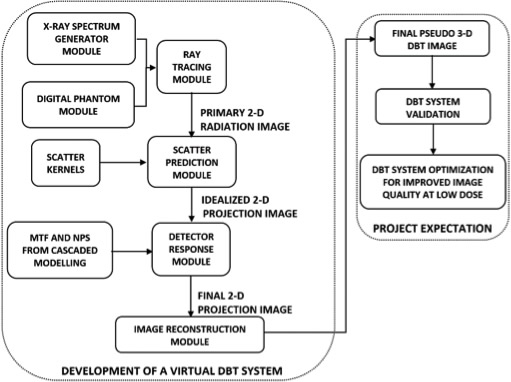
Research Index
Complete 3-D Image Simulation Framework for DBT Optimization
A. Sengupta, C. Zhao, A.C. Konstantindis, O. Diaz, K. Bliznakova and J. Kanicki
Virtual Digital Breast Tomosynthesis (DBT) systems are recently being recognized as an innovative, cost-effective, radiation free and fast approach to optimize FDA- approved as well as novel DBT detector technologies to improve the diagnosis and assessment of breast cancer.
Our main goal is the integration of a novel image simulation framework, using already developed software tools, in combination with cascaded system analysis of x-ray detectors to simulate pseudo 3-D DBT images. First this modeling framework will be validated with clinically acquired test object images. This will give us a solid foundation to optimize the x-ray exposure conditions, acquisition geometries and detector performance to improve image quality at low dose.
The framework for the virtual DBT system, as shown in the adjoining figure, begins with the generation of a polychromatic x-ray spectrum using the x-ray generator module. This x-ray spectrum is used by a ray tracing module to produce, at different angles, the 2-D primary radiation images of synthesized 3-D-software phantoms with realistic background. The scatter prediction module then adds the effect of scattering of the x-ray photons into the 2-D primary radiation image. The ideal 2-D projection image, thus created, is then modified using detector response module, using detector properties derived from cascaded system modeling. The degraded 2-D projection images, are reconstructed using statistical image reconstruction methods to produce the final pseudo 3-D DBT image. Once this system is validated, we will attempt to improve the image quality, quantified in terms of CNR and contrast detail analysis, by varying exposure, acquisition geometry, detector response (by using cascaded modeling) and filtration parameters.
A virtual DBT system generating high quality pseudo 3-D images, at reduced doses will be developed. The improve image quality may thus facilitate the distinction between early aggressive cancers and slow-growing Ductal Carcinoma in Situ to avoid any possible over-diagnosis. Furthermore, the combination of cascaded system modelling with image simulation will allow us to predict the DBT image quality for optimized inherent parameters of the detector. Hence, we can highlight any performance limitations of the current detector technology and suggest modifications for improvements leading to reduce patient dose.

top
|

